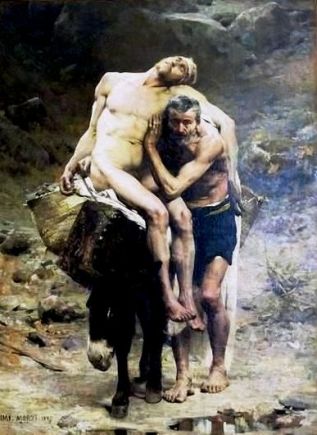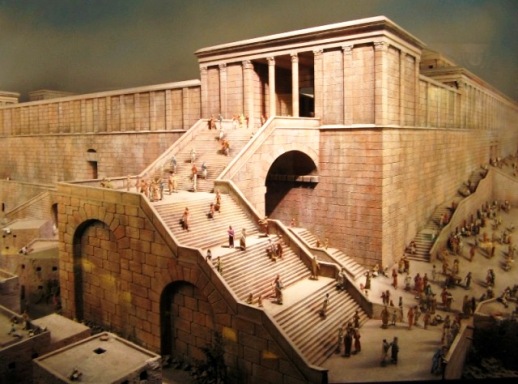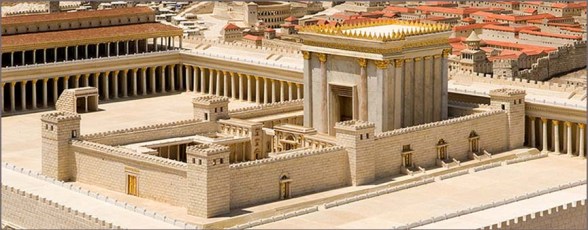The Good Samaritan
People in the story
 A Samaritan traveller on the road from Jerusalem to Jericho.
A Samaritan traveller on the road from Jerusalem to Jericho.- A priest of the Temple in Jerusalem, a highly respected man
- A Levite, a Temple official one step down from a priest
- The victim, a nameless traveller who was robbed and beaten
- The criminals who robbed him
- An inn-keeper who took in the victim
 What is the message of this Leunig cartoon? Do you agree?
What is the message of this Leunig cartoon? Do you agree?
See bottom of this page for Bible Study Activities.
The story in brief Luke’s gospel 10:25-37
A man is travelling alone on the notorious highway between Jerusalem and Jericho. He is set on by a pack of thugs who beat him savagely and rob him. They leave him to die in this isolated place. Other travellers see him lying by the side of the road, and pass on.
But a Samaritan sees him, dresses the wounds, bandages them up, props the wounded man on his own donkey, brings him to an inn, arranges bed and food for him, and makes future provisions for his care. Only then does he continue on his journey.
The message of the Good Samaritan

The Good Samaritan, Aime Morot Le Bon
The story of the Good Samaritan may be the most misinterpreted of Jesus’ parables.
It is often presented as an edifying story about a traveller who does a good deed. If this were all it was, there would be no need to make the ‘good’ man in the story a Samaritan. Any ordinary, decent Jewish man would have done just as well.
But a Samaritan as the man who behaves better than the other, Jewish, characters? To the listeners of this story when it was first told, such a concept would have turned the world upside down.
Just so. The emphasis in the story is on the doer, the Samaritan, not on the (good) deed. This is the key to its meaning.
The Good Samaritan: the true meaning
In reality, the story is about the Kingdom of God. Jesus is telling his audience that the Kingdom of God will turn human values and judgements upside down.

The Temple of Jerusalem was enormous, extraordinary.
To be a Priest of the Temple was a sacred and holy task.
Old ideas will be reversed. A person who was once despised (the Samaritan) will be held up as an example. Traditionally revered figures (the priest and Levite) and attitudes will be rejected.
The story is not a criticism of priests or Levites. Their behavior is consistent with what they stand for – ritual holiness as a mark of respect for God’s law and worship.
And the man at the side of the road, the victim, is befouled with his own blood and waste matter. This would certainly make them unclean if they touched him.
But Jesus condemns people who scrupulously follow an external law rather than being guided by internal conscience. It is a damning indictment of comfortable, entrenched prejudices, and a clarion call to adopt the new values, the new ways of living, that will be the Kingdom. The Samaritan’s actions are governed by pity.
It helps to know that
- Unlike modern lawyers, the lawyer in the story was a religious scholar. He had studied the Law of Moses in the Torah (the first five books of the Old Testament), and his task in life was to interpret this Law.
- Every Jewish man was expected to learn how to read, so that he could know the Torah well. Discussion and learning were a part of Jewish tradition. The exchange of questions was a common method of dialogue in rabbinic debates.
- A Jewish audience would have responded to the story, since there is a rich Jewish tradition of active compassion. All Jews were expected to help someone in need.

Palestine in New Testament times. Jerusalem (at bottom of map)
was only a short distance from the town of Jericho
- The Jericho referred to in the story of the Good Samaritan is not Joshua’s Jericho, where ‘the walls came tumbling down’ and Rahab the prostitute heroically hid the Hebrew spies. 1st century Jericho was a mile and a half south of the ancient city. It provided houses and services for the administrative staff that served the winter palaces at Jericho, which had been renovated and built by Herod the Great. At the time of Jesus, there was no longer a royal court in Jericho – King Herod was dead – but it was still a thriving city.
- The road from Jerusalem to Jericho winds down about 3,200ft. – Jericho is well below sea level, which is why it is so warm in winter. The road from Jerusalem passes through desert and rocky country.
- Jericho was about 18 miles from Jerusalem, further than you could walk in a day, so there were inns along the way.
- The priesthood was hereditary; you could not volunteer for it, as in the modern world. A person only belonged to it if they were born into it. It was a closed, high-ranking office.
- A Levite was a Temple official from the priestly tribe of Levi. He was one step down in status from the priest.
- ‘Priest’ and ‘Levite’ stand for the great ruling religious institutions of the Jewish nation at that time.

Reconstruction of the Temple in Jerusalem. Jewish people were justly proud
of this complex, even though they hated King Herod the Great, who built it.
- Priests and Levite had an obligation to obey laws which made them ritually clean, suitable for the prestigious task of serving in the Temple – but both men are travelling away from Jerusalem where the Temple was, not towards it.
- Probably both men live in Jericho. They may even have known each other.
- The Samaritan was a foreigner, far from home.
- He worshipped the same God as the Jewish people, but with different rituals in a temple on Mount Gerizim in Samaria. He regarded the Torah or Pentateuch as a holy book.
 To a Jew, any Samaritan was a classic villain. Jesus contradicted this entrenched stereotype. Jews and Samaritans detested each other. There were continual attacks between the two groups.
To a Jew, any Samaritan was a classic villain. Jesus contradicted this entrenched stereotype. Jews and Samaritans detested each other. There were continual attacks between the two groups.- Oil and wine were both used for medicinal purposes. Isaiah 1:6 says: “From the sole of the foot even to the head, there is no soundness in it (the body), but bruises and sores and bleeding wounds; they have not been drained, or bound up, or softened with oil.” Wine had 7 – 15% alcohol content, so it had disinfectant properties.
Think about this
- Verses 31,32,33 are about seeing; verses 25, 28, 37, 38 are about doing.
- The lawyer’s code of behavior begins with the Shema Israel in Deuteronomy 6.5 ’you shall love the Lord your God with all your heart, and with all your soul, and with all your might’; then he quotes from Leviticus 19.18: ‘you shall love your neighbor as yourself’.
- Jesus illustrates the lawyer’s Old Testament quotations with a story – but it’s a story with a twist.
- The people listening to the story expect the Jewish men, rather than the Samaritan, to know how to live according to the Torah. Jesus turns this expectation on its head.
- The Samaritan man in the story is, as far as the Jews are concerned, a socio-religious outcast. Putting the words ‘neighbor ’and ‘Samaritan’ in the same sentence seems, to Jesus’ audience, like a contradiction in terms. How can ‘good’ go with ‘Samaritan’? Their world-view is being challenged.
- Jesus makes the story vivid by giving details of what the Samaritan did:
He went to the wounded man
Bound up his wounds
Poured on oil and wine
Set him on his own donkey
Brought him to an inn
Took care of him
Gave his own money to the innkeeper
Left instructions about future payment
Jesus, the master story-teller, makes the listener see, hear and feel the incident, so that the Samaritan becomes real. So does the victim of the crime. We can almost smell the blood, sweat and pain.
Jesus also uses the devices of a master story-teller: at a moment of crisis, help arrives for the wounded man. In other words, here comes the cavalry just when it’s needed.
Summary
The story of the Good Samaritan is not just about a man who does a good deed. The story is about the Kingdom of God.
Jesus tells his audience that the Kingdom of God will turn human values and judgements upside down. People must jettison their preconceived ideas about who is a good person, and who is not. Actions speak louder than words.
In the Kingdom, the first (the Priest and the Levite) will be last, and the last (the Samaritan) will be first.
Gospel Text: the Good Samaritan
25 Just then a lawyer stood up to test Jesus. “Teacher,” he said, “what must I do to inherit eternal life?”
26 He said to him, “What is written in the law? What do you read there?”
27 He answered “You shall love the Lord your God with all your heart, and with all your soul, and with all your strength, and with all your mind; and your neighbor as yourself.”
28 And he said to him, “You have given the right answer; do this, and you will live.”
29 But wanting to justify himself, he asked Jesus, “And who is my neighbor?”
30 Jesus replied, “A man was going down from Jerusalem to Jericho, and fell into the hands of robbers, who stripped him, beat him, and went away, leaving him half dead.
31 Now by chance a priest was going down that road; and when he saw him, he passed by on the other side.
32 So likewise a Levite, when he came to the place and saw him, passed by on the other side.
33 But a Samaritan while traveling came near him; and when he saw him, he was moved with pity.
34 He went to him and bandaged his wounds, having poured oil and wine on them. Then he put him on his own animal, brought him to an inn, and took care of him.
35 The next day he took out two denarii, gave them to the innkeeper, and said, “Take care of him; and when I come back, I will repay you whatever more you spend.”
36 Which of these three, do you think, was a neighbor to the man who fell into the hands of the robbers?”
37 He said, “The one who showed him mercy.” Jesus said to him, “Go and do likewise.”
The Good Samaritan – Activities
 What does this cartoon by Leunig mean to you? Do you agree?
What does this cartoon by Leunig mean to you? Do you agree?
I’m only human…
The victim in this story is reduced, in an isolated place, to total helplessness. Naked, beaten up, abandoned, half dead.
In the same situation, driving along a lonely and dangerous road, seeing what looked like a dead body – what would you do? Isn’t what the priest and the Levite do understandable? If so, what point is Jesus making? Discuss.
The Kingdom is Now
What difference has being a Christian made to your life? Make a list of ways it has changed you.
Are you happy with that list, or is there something more you could be doing?
Spend some time thinking about this.
Search Box
![]()
© Copyright 2006
Elizabeth Fletcher








